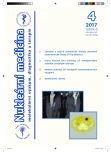-
Medical journals
- Career
Fluidothorax on lung perfusion scintigraphy
Authors: Otto Lang 1,2; Ivana Kuníková 1
Authors‘ workplace: Klinika nukleární medicíny, 3. LF UK a FNKV, Praha 10, ČR 1; Oddělení nukleární medicíny, ON Příbram a. s., ČR 2
Published in: NuklMed 2017;6:74-75
Category:
Overview
77-y-old patient was sent to our department for a lung scintigraphy due to a dyspnea. He was been treated for a chronic myeloid leukemia, he had a recurrent fluidothorax in his history. Lung perfusion scintigraphy revealed non-segmental perfusion defect in the lower part of the right lung (Fig. 1), so SPECT/CT imaging was performed. It confirmed bilateral fluidothorax, more severe on the right side, which corresponded with the perfusion defect (Fig. 2). Lateral images in the upright position were then performed to assess if the fluid is free or encapsulated and to improve interpretation towards an embolism. The perfusion defect partially changed its position and both lungs changed their shape – dorsal borders changed from linear to convex – it is more apparent on the right side (Fig. 3). It confirmed partially free fluid. Fluidothorax can mimic both segmental and non-segmental perfusion defects and it cannot be visible on chest X-ray sometimes. Pulmonary embolism can be one of its causes. SPECT/CT is a useful imaging method to assess the role of fluidothorax or other parenchymal changes on detected perfusion abnormalities. If it is not available, lateral views performed in an upright position can solve this problem. We excluded pulmonary embolism and further clinical course confirmed our conclusion. Patient dyspnea disappeared after subsequent thoracocentesis.
Key words:
fluidothorax, pulmonary embolism, scintigraphy, body position
Sources
1. Goldberg SN, Richardson DD, Palmer EL et al. Pleural Effusion and Ventilation/Perfusion Scan Interpretation for Acute Pulmonary Embolus. J NuclMed 1996;37 : 1310-1313
2. Gottschalk A, Sostman HD, Coleman RE, et al. Ventilation-perfusion seintigraphy in the PIOPED study. Part II. Evaluation of the scintigraphic criteria and interpretations. J NuclMed 1993;34 : 1119-1126
3. Bedont RA. Datz FL. Lung scan perfusion defects limited to matching pleural effusions: low probability of pulmonary embolism. AJR 1985;145 : 1155-1157
4. Light RW. Pleural effusion in pulmonary embolism. Semin Respir Crit Care Med 2010;31 : 716–722
5. Stein PD, Terrin MI, Hales CA, et al. Clinical, laboratory, roentgenographic,and electrocardiographic findings in patients with acute pulmonary embolism and no preexisting cardiac or pulmonary disease. Chest 1991;100 : 598–603
6. Findik S. Pleural effusion in pulmonary embolism. Curr Opin Pulm Med 2012,18 : 347–354
Labels
Nuclear medicine Radiodiagnostics Radiotherapy
Article was published inNuclear Medicine

2017 Issue 4
Most read in this issue- Detection of deep venous thrombosis on labeled leukocytes scan
- Fluidothorax on lung perfusion scintigraphy
- An implementation and using of a simple radiochemical purity assessment method of [99mTc]-etifenin
- Detection of splenosis on somatostatin receptor scintigraphy – a case report
Login#ADS_BOTTOM_SCRIPTS#Forgotten passwordEnter the email address that you registered with. We will send you instructions on how to set a new password.
- Career

